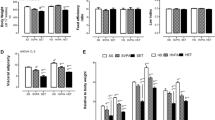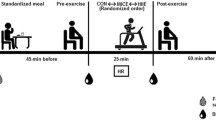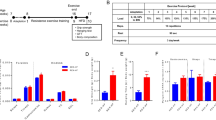Abstract
Introduction
A sedentary lifestyle and high-fat feeding are risk factors for cardiometabolic disorders. This study determined whether moderate exercise training prevents the cardiometabolic changes induced by a high-fat diet (HFD).
Materials and methods
Sixty-day-old rats were subjected to moderate exercise three times a week for 30 days. After that, trained rats received a HFD (EXE-HFD) or a commercial normal diet (EXE-NFD) for 30 more days. Sedentary animals also received the diets (SED-HFD and SED-NFD). Food intake and body weight were measured weekly. After 120 days of life, analyses were performed. Data were analysed with two-way ANOVA and the Tukey post-test.
Results
Body weight gain induced by HFD was attenuated in trained animals. HFD reduced food intake by approximately 30 % and increased body fat stores by approximately 75 %. Exercise attenuated 80 % of the increase in fat pads and increased 24 % of soleus muscle mass in NFD animals. HFD induced a hyper-response to glucose injection, and exercise attenuated this response by 50 %. Blood pressure was increased by HFD, and the beneficial effect of exercise in reducing blood pressure was inhibited by HFD. HFD increased vagal activity by 65 % in SED-HFD compared with SED-NFD rats, and exercise blocked this increase. HFD reduced sympathetic activity and inhibited the beneficial effect of exercise on ameliorating sympathetic activity.
Conclusion
Four weeks of moderate exercise at low frequency was able to prevent the metabolic changes induced by a HFD but not the deleterious effects of diet on the cardiovascular system.





Similar content being viewed by others
References
Casazza K, Dulin-Keita A, Gower BA, Fernandez JR (2009) Differential influence of diet and physical activity on components of metabolic syndrome in a multiethnic sample of children. J Am Diet Assoc 109(2):236–244
Lopez-Jaramillo P, Lahera V, Lopez-Lopez J (2011) Epidemic of cardiometabolic diseases: a Latin American point of view. Ther Adv Cardiovasc Dis 5(2):119–131
Ervin RB (2009) Prevalence of metabolic syndrome among adults 20 years of age and over, by sex, age, race and ethnicity, and body mass index: United States, 2003–2006. Natl Health Stat Rep 5(13):1–7
Deshmukh-Taskar PR, O’Neil CE, Nicklas TA, Yang SJ, Liu Y, Gustat J et al (2009) Dietary patterns associated with metabolic syndrome, sociodemographic and lifestyle factors in young adults: the Bogalusa heart study. Public Health Nutr 12(12):2493–2503
Buettner R, Scholmerich J, Bollheimer LC (2007) High-fat diets: modeling the metabolic disorders of human obesity in rodents. Obesity 15(4):798–808
pBarnes MJ, Lapanowski K, Conley A, Rafols JA, Jen KL, Dunbar JC (2003) High fat feeding is associated with increased blood pressure, sympathetic nerve activity and hypothalamic mu opioid receptors. Brain Res Bull 61(5):511–519
Gomes RM, Tofolo LP, Rinaldi W, Scomparin DX, Grassiolli S, Barella LF et al (2013) Moderate exercise restores pancreatic beta-cell function and autonomic nervous system activity in obese rats induced by high-fat diet. Cell Physiol Biochem 32(2):310–321
Prior LJ, Eikelis N, Armitage JA, Davern PJ, Burke SL, Montani JP et al (2010) Exposure to a high-fat diet alters leptin sensitivity and elevates renal sympathetic nerve activity and arterial pressure in rabbits. Hypertension 55(4):862–868
Wang H, Storlien LH, Huang XF (1999) Influence of dietary fats on c-Fos-like immunoreactivity in mouse hypothalamus. Brain Res 843(1–2):184–192
Chen F, Cham JL, Badoer E (2010) High-fat feeding alters the cardiovascular role of the hypothalamic paraventricular nucleus. Am J Physiol Regul Integr Comp Physiol 298(3):R799–R807
Matsuo T, Iwashita S, Komuro M, Suzuki M (1999) Effects of high-fat diet intake on glucose uptake in central and peripheral tissues of non-obese rats. J Nutr Sci Vitaminol 45(5):667–673
Armitage JA, Burke SL, Prior LJ, Barzel B, Eikelis N, Lim K et al (2012) Rapid onset of renal sympathetic nerve activation in rabbits fed a high-fat diet. Hypertension 60(1):163–171
Schwartz JH, Young JB, Landsberg L (1983) Effect of dietary fat on sympathetic nervous system activity in the rat. J Clin Investig 72(1):361–370
Barella LF, de Oliveira JC, Branco RC, Camargo RL, Gomes RM, Mendes FC et al (2012) Early exposure to a high-fat diet has more drastic consequences on metabolism compared with exposure during adulthood in rats. Horm Metab Res 44(6):458–464
Afonso RA, Lautt WW, Schafer J, Legare DJ, Oliveira AG, Macedo MP (2010) High-fat diet results in postprandial insulin resistance that involves parasympathetic dysfunction. Br J Nutr 104(10):1450–1459
Scomparin DX, Grassiolli S, Marcal AC, Gravena C, Andreazzi AE, Mathias PC (2006) Swim training applied at early age is critical to adrenal medulla catecholamine content and to attenuate monosodium l-glutamate-obesity onset in mice. Life Sci 79(22):2151–2156
Levin BE (2005) Factors promoting and ameliorating the development of obesity. Physiol Behav 86(5):633–639
Dishman RK, Berthoud HR, Booth FW, Cotman CW, Edgerton VR, Fleshner MR et al (2006) Neurobiology of exercise. Obesity 14(3):345–356
Rothman SM, Griffioen KJ, Wan R, Mattson MP (2012) Brain-derived neurotrophic factor as a regulator of systemic and brain energy metabolism and cardiovascular health. Ann NY Acad Sci 1264(1):49–63
Wang Q, Wang M, Whim MD (2013) Neuropeptide y gates a stress-induced, long-lasting plasticity in the sympathetic nervous system. J Neurosci 33(31):12705–12717
Malta A, de Oliveira JC, Ribeiro TA, Tofolo LP, Barella LF, Prates KV, et al. (2014). Low protein diet in adult male rats has long term effects on metabolism. J Endocrinol 221(2):285–295
Chao PT, Terrillion CE, Moran TH, Bi S (2011) High-fat diet offsets the long-lasting effects of running-wheel access on food intake and body weight in OLETF rats. Am J Physiol Regul Integr Comp Physiol 300(6):R1459–R1467
Yasari S, Paquette A, Charbonneau A, Gauthier MS, Savard R, Lavoie JM (2006) Effects of ingesting a high-fat diet upon exercise-training cessation on fat accretion in the liver and adipose tissue of rats. Appl Physiol Nutr Metab 31(4):367–375
Applegate EA, Upton DE, Stern JS (1984) Exercise and detraining: effect on food intake, adiposity and lipogenesis in Osborne–Mendel rats made obese by a high fat diet. J Nutr 114(2):447–459
Scomparin DX, Grassiolli S, Gomes RM, Torrezan R, de Oliveira JC, Gravena C et al (2011) Low-Intensity swimming training after weaning improves glucose and lipid homeostasis in MSG hypothalamic obese mice. Endocr Res 36(2):83–90
Achten J, Jeukendrup AE (2004) Optimizing fat oxidation through exercise and diet. Nutrition 20(7–8):716–727
Negrao CE, Moreira ED, Santos MC, Farah VM, Krieger EM (1992) Vagal function impairment after exercise training. J Appl Physiol 72(5):1749–1753
Vicente LL, de Moura EG, Lisboa PC, Monte Alto Costa A, Amadeu T, Mandarim-de-Lacerda CA et al (2004) Malnutrition during lactation in rats is associated with higher expression of leptin receptor in the pituitary of adult offspring. Nutrition 20(10):924–928
Milanski M, Arruda AP, Coope A, Ignacio-Souza LM, Nunez CE, Roman EA et al (2012) Inhibition of hypothalamic inflammation reverses diet-induced insulin resistance in the liver. Diabetes 61(6):1455–1462
Baudrie V, Laude D, Elghozi JL (2007) Optimal frequency ranges for extracting information on cardiovascular autonomic control from the blood pressure and pulse interval spectrograms in mice. Am J Physiol Regul Integr Comp Physiol 292(2):R904–R912
Palma-Rigo K, Baudrie V, Laude D, Elghozi JL (2010) Cardiovascular rhythms and cardiac baroreflex sensitivity in AT1A receptor gain-of function mutant mice. Hypertension 55:1507–1508
Bi S, Scott KA, Hyun J, Ladenheim EE, Moran TH (2005) Running wheel activity prevents hyperphagia and obesity in Otsuka long-evans Tokushima Fatty rats: role of hypothalamic signaling. Endocrinology 146(4):1676–1685
Patterson CM, Dunn-Meynell AA, Levin BE (2008) Three weeks of early-onset exercise prolongs obesity resistance in DIO rats after exercise cessation. Am J Physiol Regul Integr Comp Physiol 294(2):R290–R301
Borst SE, Conover CF (2005) High-fat diet induces increased tissue expression of TNF-alpha. Life Sci 77(17):2156–2165
Sclafani A (2001) Psychobiology of food preferences. Int J Obes Relat Metab Disor 25(Suppl 5):S13–S16
Warwick ZS, Schiffman SS (1992) Role of dietary fat in calorie intake and weight gain. Neurosci Biobehav Rev 16(4):585–596
Schutz Y, Flatt JP, Jequier E (1989) Failure of dietary fat intake to promote fat oxidation: a factor favoring the development of obesity. Am J Clin Nutr 50(2):307–314
Rinaldi B, Donniacuo M, Sodano L, Gritti G, Signoriello S, Parretta E et al (2013) Effects of sildenafil on the gastrocnemius and cardiac muscles of rats in a model of prolonged moderate exercise training. PLoS One 8(7):e69954
Sasaki H, Ohtsu T, Ikeda Y, Tsubosaka M, Shibata S (2014) Combination of meal and exercise timing with a high-fat diet influences energy expenditure and obesity in mice. Chronobiol Int 9:1–17
Cruciani-Guglielmacci C, Vincent-Lamon M, Rouch C, Orosco M, Ktorza A, Magnan C (2005) Early changes in insulin secretion and action induced by high-fat diet are related to a decreased sympathetic tone. Am J Physiol Endocrinol Metab 288(1):E148–E154
Wagener A, Schmitt AO, Brockmann GA (2012) Early and late onset of voluntary exercise have differential effects on the metabolic syndrome in an obese mouse model. Exp Clin Endocrinol Diabetes 120(10):591–597
Shima K, Shi K, Mizuno A, Sano T, Ishida K, Noma Y (1996) Exercise training has a long-lasting effect on prevention of non-insulin-dependent diabetes mellitus in Otsuka-Long-Evans-Tokushima Fatty rats. Metabolism 45(4):475–480
Laker RC, Gallo LA, Wlodek ME, Siebel AL, Wadley GD, McConell GK (2011) Short-term exercise training early in life restores deficits in pancreatic beta-cell mass associated with growth restriction in adult male rats. Am J Physiol Endocrinol Metab 301(5):E931–E940
Andreazzi AE, Scomparin DX, Mesquita FP, Balbo SL, Gravena C, De Oliveira JC et al (2009) Swimming exercise at weaning improves glycemic control and inhibits the onset of monosodium l-glutamate-obesity in mice. J Endocrinol 201(3):351–359
Scomparin DX, Gomes RM, Grassiolli S, Rinaldi W, Martins AG, de Oliveira JC et al (2009) Autonomic activity and glycemic homeostasis are maintained by precocious and low intensity training exercises in MSG-programmed obese mice. Endocrine 36(3):510–517
Van Vliet BN, Hall JE, Mizelle HL, Montani JP, Smith MJ Jr (1995) Reduced parasympathetic control of heart rate in obese dogs. Am J Physiol 269(2 Pt 2):H629–H637
Pelat M, Verwaerde P, Lazartiques E, Cabrol P, Galitzky J, Berlan M et al (1998) Variabilite temporelle et frequentielle de la pression arterielle et de la frequence cardiaque au cours du nycthemere dans un modele experimental d’hypertension arterielle avec obesite [Twenty-four hour time and frequency domain variability of systolic blood pressure and heart rate in an experimental model of arterial hypertension plus obesity]. Arch Mal Coeur Vaiss 91(8):999–1002
Morgan DA, Thedens DR, Weiss R, Rahmouni K (2008) Mechanisms mediating renal sympathetic activation to leptin in obesity. Am J Physiol Regul Integr Comp Physiol 295(6):R1730–R1736
Rahmouni K, Morgan DA, Morgan GM, Mark AL, Haynes WG (2005) Role of selective leptin resistance in diet-induced obesity hypertension. Diabetes 54(7):2012–2018
Hilzendeger AM, Morgan DA, Brooks L, Dellsperger D, Liu X, Grobe JL et al (2012) A brain leptin-renin angiotensin system interaction in the regulation of sympathetic nerve activity. Am J Physiol Heart Circ Physiol 303(2):H197–H206
Himeno E, Nishino K, Okazaki T, Nanri H, Ikeda M (1999) A weight reduction and weight maintenance program with long-lasting improvement in left ventricular mass and blood pressure. Am J Hypertens 12(7):682–690
Moraes-Silva IC, Mostarda C, Moreira ED, Silva KA, dos Santos F, de Angelis K et al (2013) Preventive role of exercise training in autonomic, hemodynamic, and metabolic parameters in rats under high risk of metabolic syndrome development. J Appl Physiol 114(6):786–791
Morvan E, Lima NE, Machi JF, Mostarda C, De Angelis K, Irigoyen MC et al (2013) Metabolic, hemodynamic and structural adjustments to low intensity exercise training in a metabolic syndrome model. Cardiovasc Diabetol 12(1):89
Mostarda C, Moraes-Silva IC, Salemi VM, Machi JF, Rodrigues B, De Angelis K et al (2012) Exercise training prevents diastolic dysfunction induced by metabolic syndrome in rats. Clinics 67(7):815–820
Barboza CA, Rocha LY, Mostarda CT, Figueroa D, Caperuto EC, De Angelis K et al (2013) Ventricular and autonomic benefits of exercise training persist after detraining in infarcted rats. Eur J Appl Physiol 113(5):1137–1146
Mostarda C, Rogow A, Silva IC, De La Fuente RN, Jorge L, Rodrigues B et al (2009) Benefits of exercise training in diabetic rats persist after three weeks of detraining. Auton Neurosci 145(1–2):11–16
Silva KA, da Silva Luiz R, Rampaso RR, de Abreu NP, Moreira ED, Mostarda CT et al (2012) Previous exercise training has a beneficial effect on renal and cardiovascular function in a model of diabetes. PLoS One 7(11):e48826
Agarwal D, Dange RB, Vila J, Otamendi AJ, Francis J (2012) Detraining differentially preserved beneficial effects of exercise on hypertension: effects on blood pressure, cardiac function, brain inflammatory cytokines and oxidative stress. PLoS One 7(12):e52569
Mattson MP, Wan R (2008) Neurotrophic factors in autonomic nervous system plasticity and dysfunction. Neuromolecular Med 10(3):157–168
Neeper SA, Gomez-Pinilla F, Choi J, Cotman CW (1996) Physical activity increases mRNA for brain-derived neurotrophic factor and nerve growth factor in rat brain. Brain Res 726(1–2):49–56
Russo-Neustadt A, Beard RC, Cotman CW (1999) Exercise, antidepressant medications, and enhanced brain derived neurotrophic factor expression. Neuropsychopharmacology 21(5):679–682
Hasegawa A (1991) Innervation of skeletal muscle by the lumbar sympathetic nervous system. Nihon Seikeigeka Gakkai zasshi 65(5):368–381
Cotman CW, Berchtold NC, Christie LA (2007) Exercise builds brain health: key roles of growth factor cascades and inflammation. Trends Neurosci 30(9):464–472
Acknowledgments
This research was supported by Grants from the Brazilian Research National Foundation: Coordenação de Aperfeiçoamento de Pessoal de Nível Superior (CAPES) by receipt of the scholarship from Ciências em Fronteiras Program (Process No. 10040/13-7) and Conselho Nacional de Desenvolvimento Científico e Tecnológico—CNPQ.
Conflict of interest
The author declares no conflict of interest.
Author information
Authors and Affiliations
Corresponding author
Rights and permissions
About this article
Cite this article
Tófolo, L.P., da Silva Ribeiro, T.A., Malta, A. et al. Short-term moderate exercise provides long-lasting protective effects against metabolic dysfunction in rats fed a high-fat diet. Eur J Nutr 54, 1353–1362 (2015). https://doi.org/10.1007/s00394-014-0816-7
Received:
Accepted:
Published:
Issue Date:
DOI: https://doi.org/10.1007/s00394-014-0816-7




